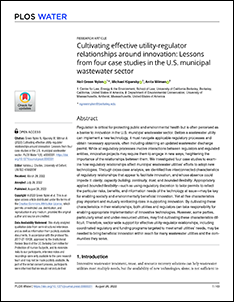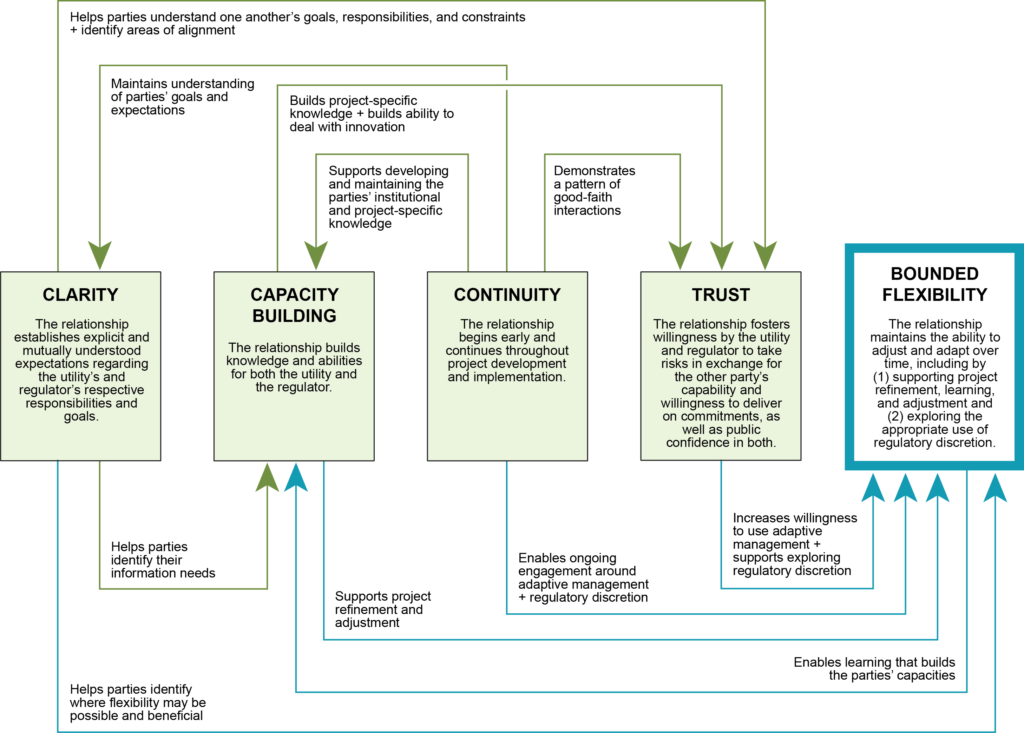The role of regulatory relationships in wastewater innovation
by Nell Green Nylen, Michael Kiparsky, and Anita Milman

Public water and wastewater utilities are increasingly struggling to meet society’s expectations. Their basic infrastructure is aging, budgets are tight, and they face a barrage of stressors, from population growth to climate change and shifting regulatory expectations. What’s more, in addition to performing their traditional function of protecting human health and water quality, many wastewater utilities are being asked to contribute to meeting other goals. For example: increasing water supply reliability, enhancing wildlife habitat, or meeting community energy needs.
Achieving these goals will take innovation—the development, application, diffusion, and utilization of new technologies and management practices. Water innovation can involve new treatment, reuse, and resource recovery technologies, including technologies that incorporate natural infrastructure. Alternatively (or in addition), innovation can take the form of new approaches to management, such as regional coordination, or increasing the efficiency of existing systems with new sensors and controls or more precise models.
However, the pace of innovation has been slow. To understand and address the causes, for the past decade, we have examined barriers to and enablers of innovation in the water sector. A key finding is that regulation, which is critical for protecting public and environmental health, can encourage or impede innovation.
We examined the role regulatory relationships play in determining regulation’s impact on wastewater innovation in a recent article: Cultivating effective utility-regulator relationships around innovation: Lessons from four case studies in the U.S. municipal wastewater sector.
Regulatory relationships and innovation
Projects that rely on new technologies and concepts often require wastewater utilities and regulators to engage in ways that differ from status quo regulatory interactions.
Novel technologies frequently involve different benefits, risks, and information needs than those in common use—especially when utility managers intend to transform their systems to more holistically address multiple community goals and needs. These differences can impede regulatory approvals for innovative projects that, if implemented, would improve social and environmental outcomes.
Standard permit terms and conditions are necessary safeguards in traditional contexts. However, they are rarely geared toward supporting innovative approaches or the iterative, adaptive processes that may be needed to manage risks, maximize benefits, and move efficiently toward full implementation of new technologies. As a result, innovative projects may require utilities and regulators to engage in new ways as they navigate unfamiliar technical, legal, and institutional territory. This dynamic heightens the importance of the relationships between them.
Characteristics of effective regulatory relationships around innovation
We developed a framework for understanding and improving relationships between regulators and wastewater utility managers seeking to implement innovative solutions. The framework draws lessons from case studies of both successful and failed attempts to implement innovative wastewater technologies. These case studies indicate a more collaborative and iterative approach to regulatory interactions could help to overcome potential regulatory barriers.
Figure 1 depicts our conceptual model of effective regulatory relationships around innovation. The model articulates five interconnected characteristics of utility-regulator relationships that were present in the three successful case studies and lacking in the failed attempt we studied. These characteristics are clarity, capacity building, continuity, trust, and bounded flexibility. Our analysis suggests that appropriately applied bounded flexibility—such as using regulatory discretion to tailor permits to reflect the particular risks, benefits, and information needs of the technology at issue—may be key for enabling socially and environmentally beneficial innovation.

Cultivating effective regulatory relationships around innovation
By working to cultivate all five characteristics in their relationships with one another, utilities and regulators can take responsibility for enabling appropriate implementation of innovative technologies.
But our research also demonstrates that some parties, especially small and under-resourced wastewater utilities, may find cultivating these characteristics difficult. Therefore, sector-wide support for effective utility-regulator relationships, including coordinated regulatory and funding programs targeted to meet small utilities’ needs, may be needed to bring beneficial innovation within reach for many wastewater utilities and the communities they serve.
This work provides crucial insights about the interplay of regulation and innovation and the centrality of regulatory relationships in determining regulatory outcomes. It establishes the empirical and conceptual underpinnings for beginning to change the culture and behavior of both wastewater utilities and regulators to support more widespread and effective innovation.
In another post, we will place this article in broader context and point the way towards spurring action on its insights.
This post reports on efforts to understand the interplay of regulation and innovation in the municipal wastewater sector, funded by the US EPA and the National Science Foundation ReNUWIt Engineering Research Center.
Reference:
Green Nylen, Nell, Michael Kiparsky, and Anita Milman. 2022. Cultivating effective utility-regulator relationships around innovation: Lessons from four case studies in the U.S. municipal wastewater sector. PLOS Water 1(8): e0000031. https://doi.org/10.1371/journal.pwat.0000031.







Reader Comments